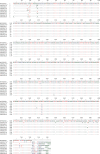Molecular Determination of Toxocara spp. Eggs Isolated from Public Parks and Playgrounds in Zahedan, Southeast Iran
- PMID: 38939904
- PMCID: PMC11208816
- DOI: 10.1155/2024/2132696
Molecular Determination of Toxocara spp. Eggs Isolated from Public Parks and Playgrounds in Zahedan, Southeast Iran
Abstract
Background: Human toxocariasis (HT) is a zoonotic disease with a global expansion. Contaminated soil with Toxocara spp. eggs is the main source of human infection, which may lead to severe complications depending on the organs invaded by migrating larvae.
Aim: This study is aimed at eliciting the prevalence of Toxocara spp. eggs in public parks in Zahedan, southeast Iran, and providing new insight into the soil contamination rate in this area using microscopic and molecular methods.
Methods: Based on five municipal districts, 240 soil samples were collected from public parks and playgrounds in Zahedan. The modified Sheather's flotation technique was employed to isolate Toxocara spp. eggs from the soil, followed by microscopic assessment and molecular evaluation of internal transcribed spacer 1 and 2 ribosomal deoxyribonucleic acid (ITS1 and 2 rDNA) using nested polymerase chain reaction (nested PCR) to identify the presence of Toxocara spp. eggs. The Sanger sequence was used to differentiate the Toxocara species. Subsequently, all the sequenced data were blasted and compared with other sequences available in the GenBank.
Results: Out of 240 soil samples collected, 7 (2.9%) samples were identified to contain Toxocara spp. eggs using Sheather's flotation and microscopic techniques. Meanwhile, 19 (7.9%) samples were positive using nested PCR. According to the Sanger sequencing analysis findings, all positive samples were contaminated with Toxocara cati.
Conclusion: As evidenced by the obtained results, only T. cati species were detected in public parks and playgrounds in Zahedan; therefore, control and prevention programs against this species should be considered in human and animal communities.
Copyright © 2024 Siavash Liravizadeh et al.
Conflict of interest statement
The authors declare that they have no conflict of interest.
Figures




Similar articles
-
Molecular characterization of Toxocara spp. eggs isolated from public parks and playgrounds in Shiraz, Iran.J Helminthol. 2019 May;93(3):306-312. doi: 10.1017/S0022149X18000354. Epub 2018 May 7. J Helminthol. 2019. PMID: 29733009
-
Environmental contamination with Toxocara spp. eggs in public parks and playground sandpits of Greater Lisbon, Portugal.J Infect Public Health. 2018 Jan-Feb;11(1):94-98. doi: 10.1016/j.jiph.2017.05.002. Epub 2017 May 22. J Infect Public Health. 2018. PMID: 28545900
-
Comparison of the Detection of Toxocara Spp. in the Soils of Public Parks of Ahvaz (Southwest of Iran) by PCR and Loop-Mediated Isothermal Amplification (LAMP).Infect Disord Drug Targets. 2021;21(3):375-383. doi: 10.2174/1871526520666200715100433. Infect Disord Drug Targets. 2021. PMID: 32669079
-
Prevalence of Toxocara eggs in Latin American parks: a systematic review and meta-analysis.Infez Med. 2023 Sep 1;31(3):329-349. doi: 10.53854/liim-3103-7. eCollection 2023. Infez Med. 2023. PMID: 37701393 Free PMC article. Review.
-
Seroprevalence of Toxocara spp. infection in Southeast Asia and Taiwan.Adv Parasitol. 2020;109:449-463. doi: 10.1016/bs.apar.2020.01.020. Epub 2020 Feb 5. Adv Parasitol. 2020. PMID: 32381212 Review.
References
LinkOut - more resources
Full Text Sources
Research Materials
Miscellaneous

